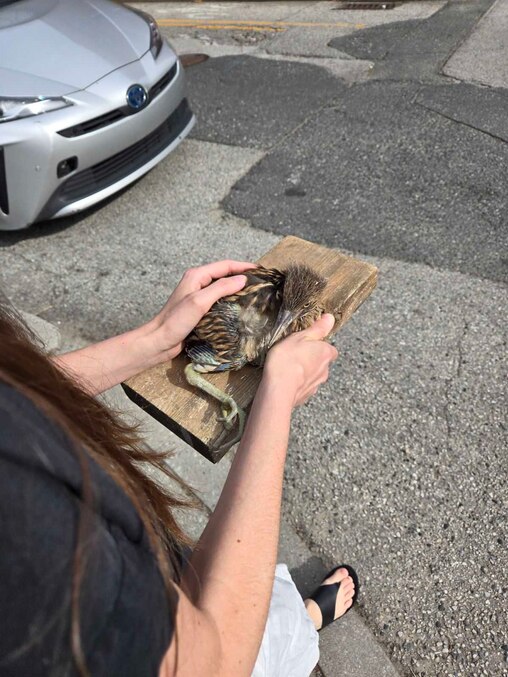If you hang around Thames Street Park long enough, you might see puffs of brown feathers fall from the trees.
The small park has become a seasonal home for black-crowned night herons. The birds, like many Baltimoreans, spend time in Fells Point when the weather is nice to get some fresh seafood and find a mate. This small park, which only has a handful of trees, is full of throaty squawks and dried bird droppings.
The herons usually live in wetlands, and while Fells Point was once a wetland centuries ago, it’s become a hard landing spot for the birds.
“That’s a pretty wild location to find them,” said Dave Brinker, avian conservation ecologist with the Maryland Department of Natural Resources.
The Baltimore Banner thanks its sponsors. Become one.
The birds are found globally but in Maryland are usually found in marshes throughout the Chesapeake Bay. Those wetlands are lush with overgrowth where fledglings can safely fall from their nests while learning to fly. They can usually scamper back up the brush and small trees to return to their nests, he said.
But at Thames Street Park, the birds are nesting in mature ornamental trees with nothing but concrete below. And it doesn’t take long to find a resident with a rescue story.
Chris Richards and Katie Schlaffer were walking their dog one Sunday morning in June when they noticed a young heron on the sidewalk. They quickly grabbed a nearby plank of wood to use as a makeshift stretcher and then drove it to the Phoenix Wildlife Center roughly 25 miles north, which has become a rescue hub for these birds. They knew about the rescue center after seeing someone post a similar story on Facebook just days before.

Another resident, Stephen Verges, rescued a fallen bird in late May with the assistance of a local business owner. A few days later, he rescued another fallen heron with the assistance of someone in the area who happened to work for the Office of Animal Control. Both birds ended up at the Phoenix Wildlife Center. “Spend a week at this park and you’ll find one on the ground too,” he said.


Baltimore is not the only city with a fallen fledgling phenomenon. The Oakland Zoo rescued 140 young, black-crowned night herons in 2022.
The Baltimore Banner thanks its sponsors. Become one.
The size of a fallen heron provides context. A small chick was likely knocked out of its nest by older siblings that didn’t want to share food, said Andrea Howey-Newcomb of Tri-State Bird Rescue & Research. Fledglings are larger: old enough to crawl but too young to fly. They leave the nest willingly, sometimes stranding themselves in an urban environment.
“Before becoming a birdnapper, always call your local wildlife rehabilitator to see if you should intervene,” she said.
Kevin Marshall, a nearby resident, first noticed herons in the park around five years ago. Lately, he’s become a sort of vigilante scientist for the colony, visiting the park almost daily to tally the birds and share his findings on an Instagram fan account he created earlier this year.
On June 4, he counted over 60 herons nesting in eight trees.
“I haven’t found any fallen fledglings myself, which is why it’s super awesome to hear that a bunch of other folks are keeping watch,” he said.
The Baltimore Banner thanks its sponsors. Become one.
As autumn arrives, the urban birds usually migrate to the Southeastern states for winter. Come spring, they journey back north. And they aren’t the only night herons in town: Wyman Park is home to yellow-crowned night herons as well.
“People should know it’s pretty cool that these birds are in Fells Point,” said Brinker of the Maryland DNR. “It’s like they’re on an island in a sea of humanity.”
If you find a fallen bird, call a licensed wildlife rehabilitator for instructions. You can reach the Phoenix Wildlife Center at 410-628-9736 and Tri-State Bird Rescue & Research at 302-737-9543.





Comments
Welcome to The Banner's subscriber-only commenting community. Please review our community guidelines.